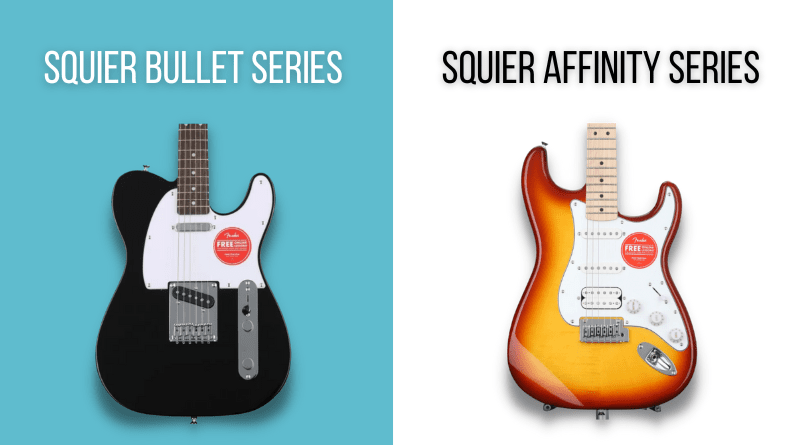Fender has put a lot of effort into the Squier brand in recent years, and it’s now paying off dividends. What was, for a time, seen as a brand making junk guitars, sullying the good name of models like the Stratocaster and Telecaster, has now become a legitimate player, not only in the entry level segment, but also amongst affordable instruments for working musicians, too, with a wide range of excellent guitars on offer.
In this KillerGuitarRigs Guide, we’ll be focusing on the entry level of Squier’s lineup. Specifically, the Bullet, and Affinity Series’. Thanks to their low price points, excellent reputation for quality, and of course the brand recognition, these are some of the most popular beginner guitars on the market.
Keep on reading to find out more about the differences between the Squier Bullet and Squier Affinity series.
Read more about our review process.
Contents
- Bullet vs. Affinity Overview
- Squier Affinity Series
- History of Squier
- Squier Bullet vs Squier Affinity – Features
- Squier Bullet vs Squier Affinity – Build Quality
- Squier Bullet vs Squier Affinity – Tones
- Famous Squier Players
- Our Favorite Squier Bullet and Affinity Models
- Which is Better – Squier Bullet or Squier Affinity?
- Final Thoughts on Squier Bullet vs Squier Affinity
Bullet vs. Affinity Overview
Because both of these series are priced so similarly, it can sometimes be difficult to tell what the difference is, and even harder to figure out why you might want to pay more for the slightly higher priced Affinity line.
Below we’ve prepared a quick snapshot of both lines to get started:
Squier Bullet Series:
- There are 4 models in this range – 2 Stratocasters (SSS and HSS), Telecaster, and Mustang
- They range in price from $170 to around $200
- They are made in China (Telecaster) and Indonesia (Stratocaster and Mustang)
- All feature poplar bodies and maple necks
Squier Affinity Series
- There are 7 models in this range – 3 Stratocasters (SSS, HSS, and HH), Telecaster, Telecaster Deluxe, Jazzmaster, and Starcaster
- They vary in price from around $250 to around $350 depending on the model
- They are manufactured in China (Jazzmaster, Telecaster Deluxe) and Indonesia (Stratocaster, Telecaster, Starcaster)
- All feature poplar bodies and maple necks, except the Starcaster, which has a laminated maple body
History of Squier
Squier is a subsidiary of Fender and produces lower priced versions of Fender guitar models. Squier guitars are manufactured in China and Indonesia, today, but in the past have also been built in India, Japan, Korea, Mexico and even the United States.
Squier started life as the V. C. Squier Company, and were founded back in 1890. The company was started by Victor Carroll Squier and ran operations from Battle Creek, MI. Originally, they only manufactured strings for various stringed instruments. Fender acquired the Squier brand back in 1965, and used their operation to produce strings for Fender guitars.
In 1972, Fender shuttered Squier’s operations, although they maintained the rights to the company name. They eventually resurrected the Squier brand in 1982 when they sought to rebrand their foreign made low budget models.
The first Squier branded guitars were released in 1982 and were designed to be affordable alternatives to the expensive Fender Stratocasters and Telecasters that were popular at the time, and also provide a way for Fender to directly compete with the Japanese built knock offs that were flooding the market at the time.
Squier has been making Bullet Series guitars since the early days of the brand. The Squier Bullets were first sold in 1983, and have always been the brand’s entry level series. There have been more than 2 dozen different Bullet guitars built by Squier over the years, and we’re sure that more will follow.
In 1997, Squier went on to introduce the Affinity Series. This line started with just the Telecaster, and then in 1999, they introduced the Affinity Stratocaster Standard. These Early affinity guitars are now some of the most sought after, thanks to their full thickness bodies, making them more compatible with upgraded Fender components.
Squier Bullet vs Squier Affinity – Features
There are surprisingly few differences between the features on models from these lines.
Bodies
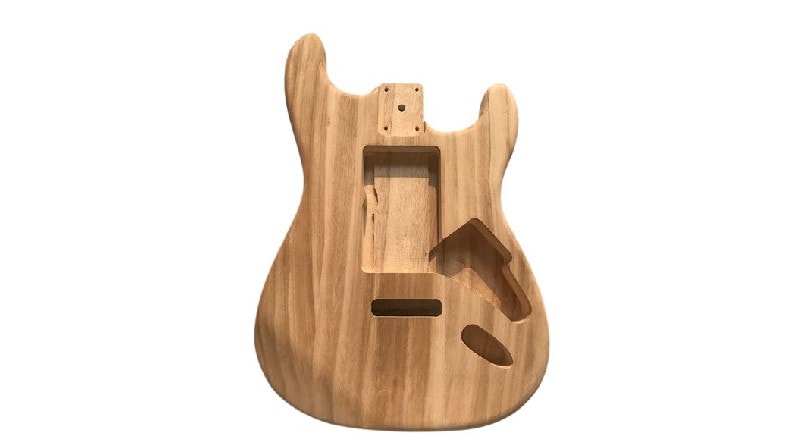
Both the Bullet and Affinity series mostly use poplar for their bodies. The one exception is the Affinity Starcaster (full review here), which is made with a laminated maple body. It’s not immediately apparent as to whether the quality of wood is any better on the Affinity models, and because they all have solid finishes or sunburst finishes with veneers, it’s difficult to even see the grain of the wood in most cases.
The body thickness on both Bullet and Affinity series is thinner than you’d find on the standard Fender branded versions of the same guitars, too. It used to be the case with early Affinity models that they would have full thickness bodies, but since the 2000’s, they have made use of the narrower size.
One last significant difference is on the construction of the Telecaster bodies. The Affinity Telecaster features a string through body as is “technically correct” for a Tele. The Bullet Telecaster on the other hand, has string through saddles. It is worth noting, however, that certain FSR (Fender Special Run) edition Squier Bullet Telecasters do feature string through bodies.
Necks
In all cases, the Bullet and Affinity series both make use of maple necks with skunk stripes, and all feature the same C shape profile. The branding on the headstock is one minor difference, with flashier gold text on the Squier logo on the Affinity models vs the plain black on the Bullet guitars.
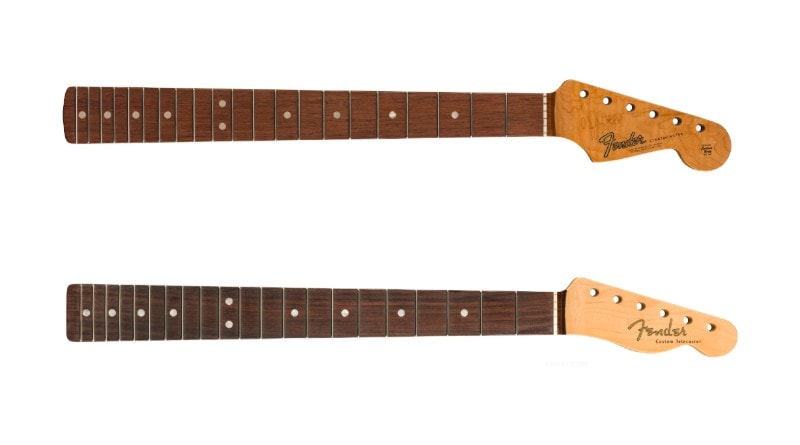
We will say that the neck finish on the Affinity series models is ever so slightly nicer. Both are satin finishes, but on the bullet models the necks feel borderline unfinished, and perhaps just a little bit rough.
Electronics
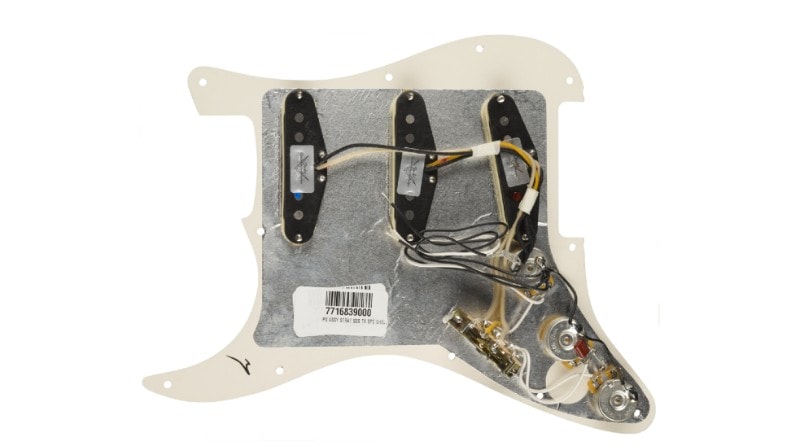
Another area in which there is a difference (on paper at least) between the Affinity and Bullet series is with the electronics. The Affinity series are equipped with Squier pickups that were voiced in house at Fender. The Bullet series get Squier Standard pickups, which don’t have much of any information relating to where they were voiced and by whom.
To be brutally honest, there is very little audible difference between the two as far as we can tell. For example, when playing a Bullet Tele and an Affinity Tele back to back with the same pot settings and the same amp settings, we couldn’t tell the difference in a blind test.
Hardware
The most notable difference in the hardware between the 2 series is the difference in the Stratocaster bridges. The Bullet series Strat is only available with a hardtail bridge, while the Affinity series only comes with a synchronized tremolo bridge.
If you’re desperate to have a vibrato system, we suggest looking at the Affinity, of course, although, being a cheaper system, it doesn’t hold up well to heavy use, and for that reason, you might actually prefer the tuning stability afforded by the bullet’s hardtail.
Squier Bullet vs Squier Affinity – Build Quality
Build quality is always going to be of prime importance when picking a guitar, especially when considering a budget model. Electronics and the majority of hardware can always be upgraded or replaced, but things like warped necks can render a guitar unplayable, and cost almost as much as a new instrument to replace.
Fortunately, Squier, being a Fender brand, needs to ensure that their guitars pass quality control, and that unplayable instruments don’t find their way into consumers’ hands or they risk damaging the Fender brand as a whole.
For that reason, no matter whether you opt for a Bullet or an Affinity, you’re largely getting the same quality. Both series use the same tuners, the same bridges and saddles, and we suspect the same fret wire.
The hardware is made from stamped pot metal, and while not comparable to stainless steel or other more premium alloys, it does its job well.
Squier Bullet vs Squier Affinity – Tones
As briefly mentioned above, in a blind test, we were unable to really tell the difference between the like for like models, despite the Affinity series having Fender voiced pickups. The once exception being with the Telecasters – we did notice better sustain on the Affinity model, which we put down to the string through body transferring more string vibration through the guitar.
Of course, the Affinity series does win out in this category overall, primarily because there are more unique guitars in that line up. Between offering a HH Strat, a HH Tele, and of course the Jazzmaster and Starcaster, there is much more tonal variety amongst the Affinities.
Famous Squier Players
Even though Squier are known for their budget friendly entry level guitars, that doesn’t mean that they aren’t good enough to gig with, as evidenced by the number of high profile professionals who have picked up these guitars for the stage and studio.
George Harrison – The Beatles
Of course, Squier wasn’t making guitars while The Beatles were still together, but their lead guitarist, George Harrison, frequently used a Japanese made Squier Stratocaster Silver Series after parting ways with the band. He most famously used this guitar during the Prince’s Trust Rock Gala in 1987.
Omar Rodriguez-Lopez – At The Drive In
Omar Rodriguez-Lopez, the front man of Post-Hardcore titans, At The Drive In, used a Squier Supersonic as his number one guitar during the Relationship of Command era, arguably at the peak of the band’s success. Like many artists, he modified his guitar, in his case removing the neck pickup and toggle switch.
Courtney Love – Hole
Courtney Love worked with Squier to design a signature model that she herself ended up using on stage, the Squier Vista Venus. The guitar was inspired heavily by both the Stratocaster and the Rickenbacker 360, and retailed at $699 for the 6 string, and $999 for the 12 string – hefty price tags for a Squier!
Joe Trohman – Fall Out Boy
Joe Trohman of Fall Out Boy not only plays a custom Squier Telecaster, he even has his own signature model. His Squier of choice is based on an early ‘70s Tele, and features an unusual HSH pickup layout, perfect for his high energy pop punk sound.
Jeff Healey
Jeff Healey was an incredibly popular Canadian jazz, blues, and rock guitarist who was widely known for his use of Squier guitars, specifically Japanese Squier Stratocasters modified with red single coil Evans pickups. He additionally used custom Squier Vista Strats loaded with Seymour Duncan SH-5 pickups.
Our Favorite Squier Bullet and Affinity Models
Below we’ve detailed our favorite guitar from each series. Of course, there are a lot to choose from, but these two really stand out for us, and we’d gladly recommend them to players looking for a quality, entry level guitar.
Our Favorite Bullet Series Model
Squier Bullet Telecaster
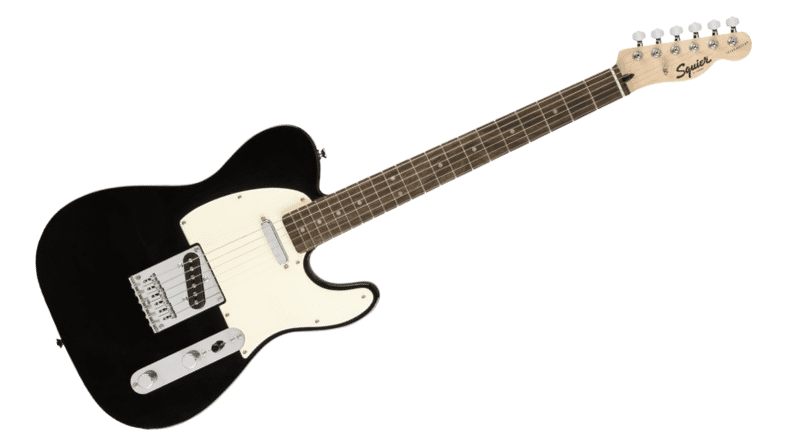
Of all of the Bullet Series Squier models, our favorite is the Squier Bullet Telecaster. Despite the low price and entry level features, it’s an absolute riot to play. It still offers many of the features that draw players to this model, and is capable of some great tones with the right amp and EQ setup.
The C shape neck profile is extremely comfortable, and definitely forgiving for beginners and players with small hands. In our experience, the frets tend to be well finished, and the Indian laurel fretboard is better than average for the price bracket that this guitar sits in.
The poplar body is light weight, resulting in a guitar that’s extremely comfortable to play for extended periods. We would have preferred a string through body – this was something that the old Bullets had, and the Affinities didn’t – so we suspect Squier wanted to better differentiate between the two on the latest version. However, string changes are marginally easier on string through saddles like these, so it was slightly better suited to beginners.
These Bullet Telecasters have an extremely bright voicing, in fact far brighter than most Teles, and this is derived from the extremely hot ceramic single coil pickups.
The main thing is, though, that the bridge position delivered the authentic Tele “twang”, while the neck pickup gave us some great clean rhythm sounds.
Our Favorite Affinity Series Model
Squier Affinity Series HSS Stratocaster
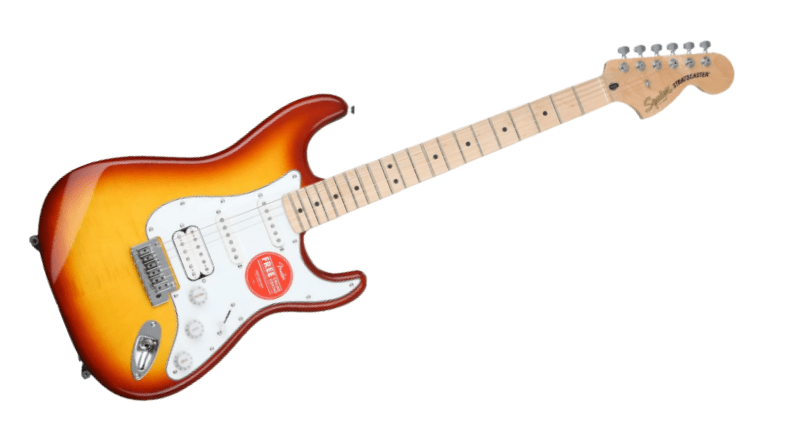
This Squier Affinity Series HSS Stratocaster, is in our opinion, one of the best looking guitars Squier has ever made. It features an absolutely stunning flamed maple top, and is available in Black or Sienna Sunburst (we think the Sienna Sunburst is the better looking of the two!)
It had a maple neck with a comfortable C shape profile. We thought it had good ergonomics, it was easy to reach for notes, and didn’t cause any hand fatigue. The fretboard was also maple, which looked great paired with the Sienna Sunburst body. The finish on the back of the neck was smooth, and really encouraged fast play.
The fretwork was good, and despite not having the world’s most polished frets, there were no sharps or burrs, and everything was level. Basically, everything you could ask for in frets at this price point.
This version of the Strat came with the HSS setup, meaning it had a humbucker in the bridge position, and single coils in the neck and middle. We think this is a great layout for a Strat, as it gives the best of both worlds – you can still get the quack from the 2 and 4 positions, and it had the creamy Strat neck tones that keep players coming back to this model.
Which is Better – Squier Bullet or Squier Affinity?
On paper, you’d think it would be easy to just call it a day and say that the more expensive Affinity Series is the best. But that wouldn’t be telling the whole story. While you could objectively say that the Affinity guitars in many cases have better specs, you could also say that the upgrades aren’t necessarily worth the difference in price (on a model for model basis).
Final Thoughts on Squier Bullet vs Squier Affinity
We’re big fans of Squier guitars at KGR, so of course these 2 staples of the lineup are incredibly popular amongst the team. In both cases, the guitars are well made, comfortable to play, and genuinely sound good. Are they going to be able to compete with a Fender Custom Shop equivalent? Absolutely not – but, if you buy one with the understanding that they are entry level guitars that will see you through the fundamentals and into the early stages of advanced playing, you’ll be very happy.
Bullet Series models are basic, but absolutely rock solid. They’re some of the most affordable guitars available from any mainstream manufacturer, and as such are viable options for players on even the tightest of budgets.
The Affinity Series does boast a wider selection of models to choose from, as well as a better array of finishes, too.

